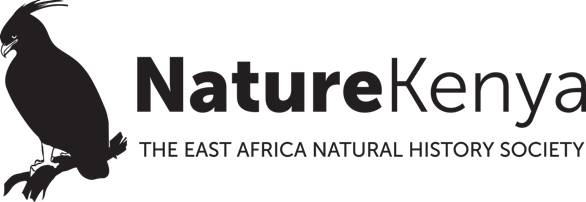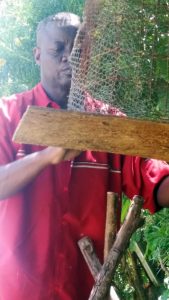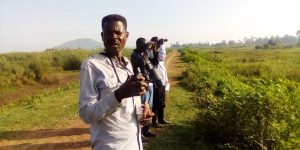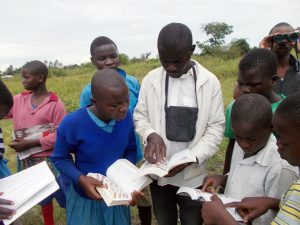Species lists, sound recordings and additional photos for this trip have been uploaded at ebird.org — see the links in the text.
It was on Monday 12 October 2020 that Pete Steward and I set off to explore Mount Kenya and Meru National Park. We were eager to pick up a few species (especially African Finfoot, Pel’s Fishing Owl and Black-and-white Shrike-flycatcher) for our Kenya and life lists on this birding trip, and it did not disappoint.
Departing Nairobi, our first stop was at the Blue Post Hotel in Thika. From here we were able to walk along the Chania and Thika rivers for a few hours where we picked up a family group of Grey-olive Greenbuls, a pair of Brown-hooded Kingfishers, a Black-throated Wattle-eye, hundreds of Eastern Golden Weavers, a sub-adult Crowned Eagle and a pair of African Hobbys. (https://ebird.org/ checklist/S74814815).
Getting back on Thika road we stopped briefly by the bridge over the Tana River for Hinde’s Babblers who readily appeared. From here, we went east around Mount Kenya headed for the Chuka Forest Station. We drove a little way into the forest on a surprisingly good road, but it was midday and very quiet except for a few pairs of Kenrick’s Starling, which flew over the road providing a welcome lifer for Pete. At one of our many birding stops in the forest, I looked up and saw what could only have been an adult Cassin’s Hawk Eagle soaring high over the forest.
From Chuka, Pete and I drove north to our overnight destination of Marania Farm, which is at an altitude of 2500- 2700m. As soon as we arrived, the farm manager, Damian Fison, took us out to the tussock grasslands on the farm, where a pair of Sharpe’s Longclaws put in an appearance before it got dark.
Back at the grasslands the next morning, we found they were heaving with high altitude specials. Common Quail seemed to call from every tussock, and Wing-snapping Cisticolas and Sharpe’s Longclaws displayed overhead. It was not long before the first Elgon Francolin (now a separate species from Moorland Francolin) called, but it took us a while to get a good look at them. After an hour of searching we found a confiding pair that fed and called a short distance from our car. (https://ebird.org/ checklist/S75437063) Not far from the francolins we found a family of Yellow-necked Spurfowl — quite bizarre to have both species present and breeding at the same site.
After a quick breakfast we headed down the mountain to Imenti Forest and opted to bird along the tracks at the edge of the forest. Highlights included Crested Guineafowl, Brown-backed Woodpecker, White-eared Barbet, Moustached Tinkerbird, Purple-throated Cuckooshrike, Black-fronted Bush-shrike, Black-headed Apalis, and Waller’s and Kenrick’s Starlings.
On the way back to the farm we took a quick detour into a forest area situated along the well-maintained road beyond Marania Forest Station. We found a recently constructed large dam having a pair of African Black Ducks and we had excellent views of Booted Eagle and a juvenile Crowned Eagle. In the early evening back on the farm Damian found us a stunning and confiding Mackinder’s Eagle Owl (https://ebird. org/checklist/S74814851). A brief drive later that night was interrupted by rain, but we did manage to see two servals, bushpigs, a few porcupine and plenty of Montane Nightjars.
We left Marania Farm the following morning at dawn and decided to stop at Imenti Forest again, gladly adding a Common Whitethroat to our list. Driving east along the Nyambene Hills we headed towards Ngaia Forest and Meru National Park. This drive is spectacular and we wished we could explore the forest patches along the way. We arrived at Ngaia Forest at the worst possible time of day, but decided to try our luck regardless. However, the main track through the forest seems to be the route taken by farmers that live on one side of the forest and who farm on the other, and the result was a steady stream of motorbikes.
This annoyance aside, the forest is spectacular and still of incredible quality. Our best birds here were a Southern Yellowbill, an Eastern Nicator and a very stoic Narina Trogon that happened to be perched and calling just metres away from music blasting from a broken down pikipiki (motorbike).
Meru National Park
We were pleased to find good numbers of migrants whilst driving through Meru National Park on the way to Rhino River Camp — Wheatears (Isabelline, Northern, and Pied) and European Rollers. We arrived at camp late in the day and opted to spend the remaining daylight hours on the nature trail going through the camp. Highlights included a family group of Retz’s Helmetshrike, a Red-capped Robin Chat, calling Eastern Nicators, a family of White-eared Barbets and hundreds upon hundreds of Eurasian Bee-eaters (https://ebird.org/checklist/ S74814861).
We started out the next day in the park’s Rhino Sanctuary where we had a calling Eastern Black-headed Batis. We then drove straight towards the Rojeweru River area east of Elsa’s Kopje and then proceeded to drive the tracks near the river. A female African Finfoot gave us a brief, but satisfactory, view. Other interesting birds included a Trumpeter Hornbill, at least two Eurasian Hoopoes, numerous Black-bellied Sunbirds, and a pair of Golden-breasted Starlings. On the way back to camp we found a Secretarybird, two Western Banded Snake Eagles, a few Steppe Eagles, and a few pairs of nesting Wahlberg’s Eagles (https://ebird.org/ checklist/S74917617).
A somewhat depressing observation was the complete absence of vultures and Tawny Eagles in the park. No doubt these birds persist here, but they must be in very low numbers. I hope I am wrong.
In the evening we opted to explore the area surrounding the old Kampi ya Nyati site in the park. On a small track we flushed a pair of finches that drew our attention. We were elated when they flew up and we found ourselves staring at a pair of Orange-winged Pytilia. Over the next 30 minutes we found multiple pairs in this general area and at one point we had 7 birds in view at the same time.
As the sun was setting, we were walking on the road back into camp when suddenly we heard a distant, but distinctive solitary hoot from along the Rojaweru River. We froze and listened carefully for a few minutes. Every 10 seconds or so the bird would call and it was the deep pure bass hoot of a Pel’s Fishing Owl. We rushed back to camp to pick up a microphone to make a recording, but the bird unfortunately did not call again that evening. (https:// ebird.org/checklist/S74917619).
We spent our final day birding around the campsite. Highlights included a confiding Southern Yellowbill, a pair of Lizard Buzzards, Jameson’s Firefinch, a family of Hinde’s Babblers, and finally one of our target species — a pair of Black-and-white Shrike-flycatchers that flew into camp right as we were leaving — a new bird for both our Kenya lists! (https://ebird. org/checklist/S75024643).
This article by Stratton Hartfield and Peter Steward appears in the current issue of Kenya Birding magazine.




